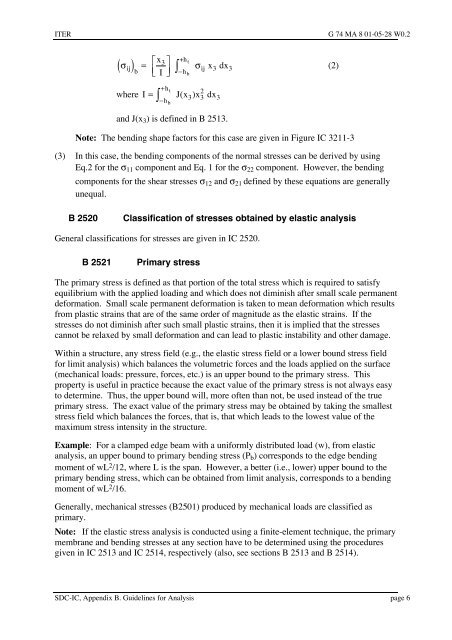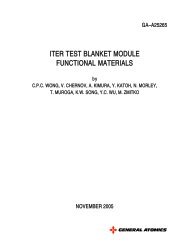iter structural design criteria for in-vessel components (sdc-ic)
iter structural design criteria for in-vessel components (sdc-ic)
iter structural design criteria for in-vessel components (sdc-ic)
You also want an ePaper? Increase the reach of your titles
YUMPU automatically turns print PDFs into web optimized ePapers that Google loves.
ITER G 74 MA 8 01-05-28 W0.2<br />
( ) = é<br />
x3<br />
s<br />
ù +ht<br />
ij s<br />
b<br />
h<br />
ij x3 dx3<br />
ëê ûú ò<br />
(2)<br />
I - b<br />
+ h<br />
=<br />
-h<br />
t<br />
where I ò J( x3) x3 dx<br />
2<br />
b<br />
and J(x3) is def<strong>in</strong>ed <strong>in</strong> B 2513.<br />
Note: The bend<strong>in</strong>g shape factors <strong>for</strong> this case are given <strong>in</strong> Figure IC 3211-3<br />
3<br />
(3) In this case, the bend<strong>in</strong>g <strong>components</strong> of the normal stresses can be derived by us<strong>in</strong>g<br />
Eq.2 <strong>for</strong> the s11 component and Eq. 1 <strong>for</strong> the s22 component. However, the bend<strong>in</strong>g<br />
<strong>components</strong> <strong>for</strong> the shear stresses s12 and s21 def<strong>in</strong>ed by these equations are generally<br />
unequal.<br />
BÊ2520 Classif<strong>ic</strong>ation of stresses obta<strong>in</strong>ed by elast<strong>ic</strong> analysis<br />
General classif<strong>ic</strong>ations <strong>for</strong> stresses are given <strong>in</strong> IC 2520.<br />
B 2521 Primary stress<br />
The primary stress is def<strong>in</strong>ed as that portion of the total stress wh<strong>ic</strong>h is required to satisfy<br />
equilibrium with the applied load<strong>in</strong>g and wh<strong>ic</strong>h does not dim<strong>in</strong>ish after small scale permanent<br />
de<strong>for</strong>mation. Small scale permanent de<strong>for</strong>mation is taken to mean de<strong>for</strong>mation wh<strong>ic</strong>h results<br />
from plast<strong>ic</strong> stra<strong>in</strong>s that are of the same order of magnitude as the elast<strong>ic</strong> stra<strong>in</strong>s. If the<br />
stresses do not dim<strong>in</strong>ish after such small plast<strong>ic</strong> stra<strong>in</strong>s, then it is implied that the stresses<br />
cannot be relaxed by small de<strong>for</strong>mation and can lead to plast<strong>ic</strong> <strong>in</strong>stability and other damage.<br />
With<strong>in</strong> a structure, any stress field (e.g., the elast<strong>ic</strong> stress field or a lower bound stress field<br />
<strong>for</strong> limit analysis) wh<strong>ic</strong>h balances the volumetr<strong>ic</strong> <strong>for</strong>ces and the loads applied on the surface<br />
(mechan<strong>ic</strong>al loads: pressure, <strong>for</strong>ces, etc.) is an upper bound to the primary stress. This<br />
property is useful <strong>in</strong> pract<strong>ic</strong>e because the exact value of the primary stress is not always easy<br />
to determ<strong>in</strong>e. Thus, the upper bound will, more often than not, be used <strong>in</strong>stead of the true<br />
primary stress. The exact value of the primary stress may be obta<strong>in</strong>ed by tak<strong>in</strong>g the smallest<br />
stress field wh<strong>ic</strong>h balances the <strong>for</strong>ces, that is, that wh<strong>ic</strong>h leads to the lowest value of the<br />
maximum stress <strong>in</strong>tensity <strong>in</strong> the structure.<br />
Example: For a clamped edge beam with a uni<strong>for</strong>mly distributed load (w), from elast<strong>ic</strong><br />
analysis, an upper bound to primary bend<strong>in</strong>g stress (Pb) corresponds to the edge bend<strong>in</strong>g<br />
moment of wL 2 /12, where L is the span. However, a better (i.e., lower) upper bound to the<br />
primary bend<strong>in</strong>g stress, wh<strong>ic</strong>h can be obta<strong>in</strong>ed from limit analysis, corresponds to a bend<strong>in</strong>g<br />
moment of wL 2 /16.<br />
Generally, mechan<strong>ic</strong>al stresses (B2501) produced by mechan<strong>ic</strong>al loads are classified as<br />
primary.<br />
Note: If the elast<strong>ic</strong> stress analysis is conducted us<strong>in</strong>g a f<strong>in</strong>ite-element technique, the primary<br />
membrane and bend<strong>in</strong>g stresses at any section have to be determ<strong>in</strong>ed us<strong>in</strong>g the procedures<br />
given <strong>in</strong> IC 2513 and IC 2514, respectively (also, see sections B 2513 and B 2514).<br />
SDC-IC, Appendix B. Guidel<strong>in</strong>es <strong>for</strong> Analysis page 6




